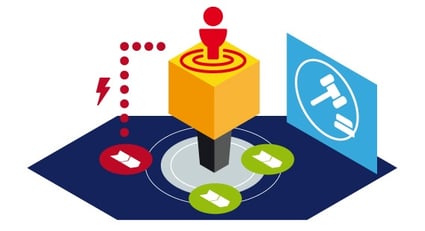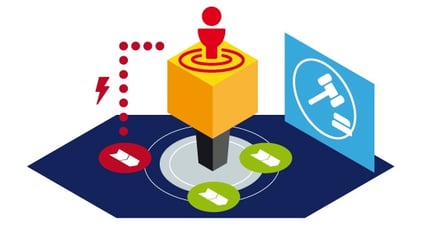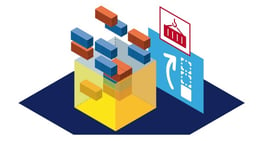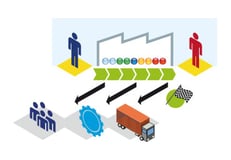The Logistics 4.0 Tipping Point
Brian Hoey - September 06, 2018

 Let’s think back for a moment to the early days of Facebook. Today, the social media giant boasts more than a billion users worldwide, but there was a time when its base was just an infinitesimal fraction of that number—a handful of early adopters scattered across American college campuses. Pretty quickly, that handful, having influenced others to join up, grew to a critical mass. People across the world felt that they had to be on Facebook because their friends were already using it, and the more users joined, the more attractive the social networking site seemed to potential users. This quickly reached a tipping point and led to the explosion of users that they’ve seen in the past few years.
Let’s think back for a moment to the early days of Facebook. Today, the social media giant boasts more than a billion users worldwide, but there was a time when its base was just an infinitesimal fraction of that number—a handful of early adopters scattered across American college campuses. Pretty quickly, that handful, having influenced others to join up, grew to a critical mass. People across the world felt that they had to be on Facebook because their friends were already using it, and the more users joined, the more attractive the social networking site seemed to potential users. This quickly reached a tipping point and led to the explosion of users that they’ve seen in the past few years.
Though many advancements in the worlds of shipping, freight forwarding, and supply chain management have had steady, gradual build-ups over time, many others, like the rise of computerized processes and the idea of the lean supply chain, have reached exactly this same sort of tipping point. As we enter the era of Logistics 4.0, a similar tipping point is fast approaching. Here are just a few of the factors that will contribute to it:
The Continued Data Explosion
Moore’s Law holds that the amount of data storage in the world will double every two years. Though there have been some suggestions that the rate, which has held for multiple decades, is beginning to slow down, the fact remains that with the advent of cloud storage and the internet of things (IoT) more data is being collected and stored than ever before—including critical logistics data like average fuel prices, transport times across different modalities, freight volumes over time, inventory levels and optimization tactics, etc. Where the shippers of the past had to rely on necessarily incomplete data when moving cargo from one place to another, the modern logistics outfit can, for example, use extensive fuel and truck pricing data to inform their decision of whether it’s cost effective to opt for a less-than-full truckload or wait for more cargo. Likewise, they can utilize traffic, tolls, and volume data when considering changing a preexisting route or opening a new hub. In this way, improved data usage helps Logistics providers the tools to overcome the age-old hurdle of past-oriented, reactive transport management. Instead of being stuck with plans that lose value by conforming only to past events, planners to shape their transport logistics around future price and demand changes with the help of new data and analytics tools.
Not only is this influx of data already changing the way that transport logistics tasks are carried out, it’s putting logistics providers in an unprecedented position. With all of this data in tow, the value of sharing information both inter- and intra-operationally will be greater than ever (since data becomes more powerful as it accumulate), and companies will feel an imperative to make this kind of information transparency possible. This will require tearing down silos in order to pave the way for real-time supply chain information, in-memory technology, and other key visibility added propositions, but the end result will be logistics processes made smarter (and thus more resistant to the unexpected) by better forecasts and a more complete picture of the entire global value stream.
Rise of the Smart Factories
You may have noticed that many of the factors listed above (real-time, in-memory technology, silo reduction, etc.) are the very underpinnings of modern Industry 4.0 systems. While the concept of Logistics 4.0 arose out of conversations about Industry 4.0 and the Fourth Industrial Revolution, it still very much represents a unique, self-sufficient paradigm. That said, the continued rise of Industry 4.0 in general and the smart factory in particular will be one of the factors that pushes the logistics industry over the edge in terms of adopting smarter, more connected workflows.
Imagine for a second that you run an Industry 4.0-enabled factory. You collect data from all touchpoints on your value chain, which is fed back into a central control tower that enables you to run advanced analytics processes to help you better predict bottlenecks and improve your workflows. When it comes time for your business to partner with a logistics provider, would you want someone whose system can’t or won’t integrate with your own? No, you’d search for a shipper who could add value not just in terms of moving goods from one place to the next, but in terms of data and technology integration. In order to implement Industry 4.0 processes in your value stream, you would have had to overcome crucial hurdles like supply chain integration and digitization, and a non-digitized logistics provider would require you to overcome those same hurdles again in a new fashion by failing to integrate with your more modern workflows.
In an ideal world, your logistics provider would provide end-to-end visibility on your products’ journey, offering real-time tracking (the better to enable real-time production feedback if shipments look to be late or damaged), offer freight and inventory optimization based on inbound and outbound pull (helping you to reduce inventory levels and achieve a leaner supply chain), and other value-added services that will add more usable, mission critical data to your own systems. In this way, it would ease collaboration and provide greater visibility and flexibility—two key value added propositions in the world of Industry 4.0. If your logistics provider couldn’t offer those services, you’d likely switch to one who could, and the non-digitized, non-integrated logistics provider would miss out on your business. This, in a nutshell, represents one of the most significant forces that will drive us towards the Logistics 4.0 tipping point.
The Global Supply Chain
Based on the heading, the last point in this post might seem a little vague. And, in a way, that’s exactly the point. As supply chains have become more global, and thus more diffuse, it has become increasingly difficult to gain a clear picture of the various touchpoints on a given value chain. This makes it harder for logistics providers and manufacturers alike to predict disruptions and maneuver through them in an agile manner. Now more than ever, turning an almost opaque level of complexity into legible, actionable information is a crucial challenge for logistics providers—a challenge that Logistics 4.0 is especially well-positioned to meet. After all, Logistics 4.0 systems aim to turn high levels of data visibility into more optimal freight and hub network structures, optimal 3D load visualizations, and more efficient risk and event management. This means that, as new freight and shipping routes proliferate, smart logistics providers can navigate ever more complicated routes and shifting modalities with ease, providing value for their customers by easing pain-points related to low visibility and constantly-changing conditions.
The alternative to adopting these new, smart workflows is to ignore the growing complexity of the global value chain, and fail to provide to provide customers with agile, adaptable shipping and freight forwarding. Not only do businesses that stay stuck in an earlier logistics era lose out on the business of Industry 4.0-enabled clients, but their own ability to meet logistics challenges erodes over time due to poor integration with an increasingly complex value stream. Meanwhile, as manufacturers grow accustomed to the conveniences of smart, connected logistics workflows, Logistics 4.0 adoption will turn the corner into rapid, unassailable growth.
LATEST POSTS
- Understand Why Production Planning Needs Specialized Solutions
- Understand Circular Economy in The Manufacturing Industry
- How Can Industry 4.0 IT Integration Be Achieved Smoothly?
- The Significance of Order Sequencing in Discrete Manufacturing
- How to improve your Supply Chain Management: The Power of Control Towers


